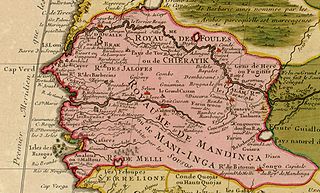 W
WThe history of Senegal is commonly divided into a number of periods, encompassing the prehistoric era, the precolonial period, colonialism, and the contemporary era.
 W
WBanque d'Afrique Occidentale : was a bank French colonial authorities established in 1901 in Dakar, Sénégal, as the central bank of the colonies of French West Africa.
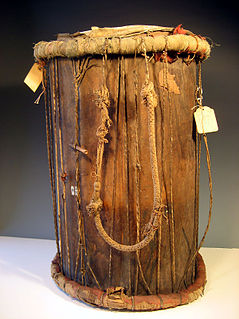 W
WThe Battle of Fandane-Thiouthioune, also known as the Battle of Somb or the Battle of Somb-Tioutioune, occurred on 18 July 1867. It was a religious war between the Serer people and the Muslim Marabouts of the 19th century in Senegal and The Gambia, but it also had a political and economic dimension to it: vendetta and empire-building. Fandane, Thiouthioune and Somb were part of the pre-colonial Serer Kingdom of Sine now part of independent Senegal.
 W
WBundu was a state in Africa, later a French protectorate dependent on the colony of Senegal. It lay between the Falémé River and the upper course of the Gambia River, that is between 13 and 15 N., and 12 and 13 W.
 W
WCayor was the largest and most powerful kingdom (1549–1879) that split off from the Jolof Empire in what is now Senegal. Cayor was located in northern and central Senegal, southeast of Walo, west of the kingdom of Jolof, and north of Baol and the Kingdom of Sine.
 W
WThe compagnie du Sénégal was a 17th-century French chartered company which administered the territories of Saint-Louis and Goree island as part of French Senegal.
 W
WThe history of Senegal is commonly divided into a number of periods, encompassing the prehistoric era, the precolonial period, colonialism, and the contemporary era.
 W
WFrench West Africa was a federation of eight French colonial territories in Africa: Mauritania, Senegal, French Sudan, French Guinea, Ivory Coast, Upper Volta, Dahomey and Niger. The federation existed from 1895 until 1958. Its capital was Saint-Louis, Senegal until 1902, and then Dakar until the federation's collapse in 1960.
 W
WThe Imamate of Futa Jallon or Jalon was a West African theocratic state based in the Fouta Djallon highlands of modern Guinea. The state was founded around 1727 by a Fulani jihad and became part of the French Third Republic's colonial empire in 1896.
 W
WThe Ghana Empire, properly known as Wagadou, was a West African empire located in the area of present-day southeastern Mauritania and western Mali. Complex societies based on trans-Saharan trade in salt and gold had existed in the region since ancient times, but the introduction of the camel to the western Sahara in the 3rd century CE, opened the way to great changes in the area that became the Ghana Empire. By the time of the Muslim conquest of North Africa in the 7th century the camel had changed the ancient, more irregular trade routes into a trade network running from Morocco to the Niger River. The Ghana Empire grew rich from this increased trans-Saharan trade in gold and salt, allowing for larger urban centres to develop. The traffic furthermore encouraged territorial expansion to gain control over the different trade routes.
 W
WThe Capture of Gorée occurred in December 1758 when a British naval expedition led by Augustus Keppel against the French island of Gorée off the coast of Senegal during the Seven Years' War.
 W
WThe House of Slaves and its Door of No Return is a museum and memorial to the Atlantic slave trade on Gorée Island, 3 km off the coast of the city of Dakar, Senegal. Its museum, which was opened in 1962 and curated until Boubacar Joseph Ndiaye's death in 2009, is said to memorialise the final exit point of the slaves from Africa. While historians differ on how many African slaves were actually held in this building, as well as the relative importance of Gorée Island as a point on the Atlantic slave trade, visitors from Africa, Europe, and the Americas continue to make it an important place to remember the human toll of African slavery.
 W
WJews of the Bilad al-Sudan describes West African Jewish communities which were connected to known Jewish communities which were expelled from the Middle East, North Africa, or Spain and Portugal and emigrated to West Africa. Various historical records state that at one time, they were present in the Ghana, Mali, and Songhai empires, which was then called the Bilad as-Sudan a name which is derived from the Arabic term which means Land of the Blacks. In later years Jews who were expelled from Spain, Portugal, and Morocco and emigrated to West Africa, also formed their own communities off the coast of Senegal as well as on the Islands of Cape Verde. These Jewish communities continued to exist for hundreds of years but they eventually disappeared as a result of changing social conditions, persecution, migration, and assimilation.
 W
WThe Jolof Empire, also known as the Wolof or Wollof Empire, was a West African state that ruled parts of Senegal from 1350 to 1549. Following the 1549 battle of Danki, its vassal states were fully or de facto independent; in this period it is known as the Jolof Kingdom.
 W
WThe Joos Maternal Dynasty was a Serer maternal dynasty which originated from the Serer pre-colonial Kingdom of Sine in the 14th century and spread to the Wolof Kingdom of Waalo. The matriarch or founder of this maternal dynasty was Lingeer Fatim Beye, a princess and queen originally from the Kingdom of Sine. In Waalo, it was founded by the princess Lingeer Ndoye Demba of Sine. Lingeer Ndoye Demba was the maternal granddaughter of Lingeer Fatim Beye. They both came from the Serer ethnic group. Although the pre-colonial Kingdoms of Sine and Waalo now form part of modern-day Senegal, in pre-colonial Senegambia, present-day Gambia had open-borders with Senegal and share the same historical and cultural heritage. The demarcation of the two countries is purely geographical due to their colonial past, with Britain colonizing the Gambia and France colonizing Senegal. For a background to these events see the History of Senegal, History of the Gambia, Senegambia and Timeline of Serer history.
 W
WLat Jor Ngone Latir Jop, son of Sahewer Sohna Mbay and the Linguère royal Ngone Latir Fal, Ngoné Latyr Fall was from the Wolof Dynasty of Paleen Dedd which ruled the two kingdoms of Cayor and Baol. Lat Joor was a nineteenth-century damel (king) of Cayor, a Wolof state that is today in south-central Sénégal. Lat Jor belonged to the Geej or Guedj Wolof maternal dynasty that has ruled Baol and Cayor for two centuries. The matriarch of that matriclan was the Wolof Lingeer Ngoné Dièye, a Princess from Tubé Dieye in Gandiol. Gandiol is a Wolof region in the north of Senegal that borders Mauritania.". Lat Jor was a direct maternal descendant of Lingeer Ngoné Dièye of Tubé Dieye.
 W
WThe Kaabu Empire (1537–1867), also written Gabu, Ngabou, and N'Gabu, was a great empire in the Senegambia region centered within modern northeastern Guinea-Bissau, larger parts of today's Gambia; extending into Koussanar, Koumpentoum, regions of Southeastern Senegal, and Casamance in Senegal. The Kaabu Empire consisted of several languages namely: Balanta, Jola-Fonyi, Mandinka, Mandjak, Mankanya, Noon (Serer-Noon), Pulaar, Serer, Soninke, and Wolof. It rose to prominence in the region thanks to its origins as a former imperial military province of the Mali Empire. After the decline of the Mali Empire, Kaabu became an independent Empire. Kansala, the imperial capital of Kaabu Empire, was annexed by Futa Jallon during the 19th century Fula jihads. However, Kaabu's vast independent kingdoms across Senegambia continued to thrive even after the fall of Kansala; this lasted until total incorporation of the remaining Kingdoms into the British Gambia, Portuguese and French spheres of influence during the Scramble for Africa.
 W
WSoumaoro Kanté was a 13th-century king of the Sosso people. Seizing Koumbi Saleh, the capital of the recently defunct Ghana Empire, Soumaoro Kanté proceeded to conquer several neighboring states, including the Mandinka people in what is now Mali. However, the Mandinka prince Sundiata Keita built a coalition of smaller kingdoms to oppose him at the Battle of Kirina, defeating the Sosso and leaving Sundiata's new Mali Empire dominant in the region.
 W
WMV Le Joola was a Senegalese government-owned roll-on/roll-off ferry that capsized off the coast of The Gambia on 26 September 2002, with 1,863 deaths and 64 survivors. It is thought to be the second-worst non-military disaster in maritime history.
 W
WThis is a list of European colonial administrators responsible for the territory of French West Africa, an area equivalent to modern-day Mauritania, Mali, Niger, Senegal, Guinea, Ivory Coast, Burkina Faso, Benin and Togo.
 W
WThe Battle of Logandème was an uprising led by the Serer King Maad a Sinig Kumba Ndoffene Famak Joof, king of Sine, against the French Empire. The battle took place at Logandème which was a part of Sine at the time. The battle was also a revenge attack against the Serer people after their resounding victory against France at the Battle of Djilass on 13th May 1859. It was the first time that France decided to employ cannonball in the Senegambia.
 W
WThe Mali Federation was a federation in West Africa linking the French colonies of Senegal and the Sudanese Republic for two months in 1960. It was founded on 4 April 1959 as a territory with self-rule within the French Community and became independent after negotiations with France on 20 June 1960. Two months later, on 19 August 1960, the Sudanese Republic leaders in the Mali Federation mobilized the army, and Senegal leaders in the federation retaliated by mobilizing the gendarmerie ; this resulted in a tense stand-off, and led to the withdrawal from the federation by Senegal the next day. The Sudanese Republic officials resisted this dissolution, cut off diplomatic relations with Senegal, and defiantly changed the name of their country to Mali. For the brief existence of the Mali Federation, the premier was Modibo Keïta, who would become the first President of the Republic of Mali after the Mali Federation dissolved, and its government was based in Dakar, Senegal.
 W
WMéduse was a 40-gun Pallas-class frigate of the French Navy, launched in 1810. She took part in the Napoleonic Wars during the late stages of the Mauritius campaign of 1809–1811 and in raids in the Caribbean.
 W
WAmédée William Merlaud-Ponty was a French colonial administrator. He was a Governor General of French West Africa (1908–1915) who particularly interested himself in the economic development and education of Africa.
 W
WPre-imperial Mali refers to the period of history before the establishment of the Mali Empire, a pre-colonial African empire located mostly in present-day Mali, in c. 1235.
 W
WThe Prime Minister of Senegal was the head of government of Senegal. The Prime Minister was appointed by the President of Senegal, who is directly elected for a seven-year term. The Prime Minister, in turn, appointed the Senegalese cabinet, after consultation with the President. On 14 May 2019, the post was abolished.
 W
WThe Royal African Company (RAC) was an English mercantile (trading) company set up in 1660 by the royal Stuart family and City of London merchants to trade along the west coast of Africa. It was led by the Duke of York, who was the brother of Charles II and later took the throne as James II. It shipped more African slaves to the Americas than any other institution in the history of the Atlantic slave trade.
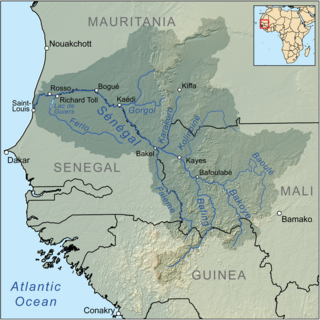 W
WA large-scale, drought-induced famine occurred in Africa's Sahel region and many parts of the neighboring Sénégal River Area from February to August 2010. It is one of many famines to have hit the region in recent times.
 W
WThe Capture of Senegal took place in 1758 during the Seven Years' War with France, as part of a concerted British strategy to weaken the French economy by damaging her international trade. To this end, a succession of small British military expeditions landed in Senegal and captured the French settlements of Saint-Louis and Gorée, seizing French vessels and supplies. By late 1758 the whole of the French colony on the Senegalese coast had been captured by the British, with administrative matters being handled by the first British Governor of Senegal, Lieutenant Colonel Richard Worge.
 W
WThe Senegalese Tirailleurs were a corps of colonial infantry in the French Army. They were initially recruited from Senegal, French West Africa and subsequently throughout Western, Central and Eastern Africa: the main sub-Saharan regions of the French colonial empire. The noun tirailleur, which translates variously as "skirmisher", "rifleman", or "sharpshooter", was a designation given by the French Army to indigenous infantry recruited in the various colonies and overseas possessions of the French Empire during the 19th and 20th centuries.
 W
WSenegambia, also known in Dutch as Bovenkust, was the collective noun for the fortifications and trading posts owned by the Dutch West India Company (DWIC) in the region now known as Senegal. The main purpose of these trading posts was to obtain slaves in order to ship them to the Americas. The government of the territory was based on Gorée. In 1677, the Dutch lost this island to France. The next year, the French also conquered all DWIC trading posts on the Senegalese coast as well as the island of Arguin.
 W
WSenegambia and Niger was a short-lived administrative unit of the colonial French West Africa possessions, in the region of present-day Niger, Mali and Senegal.
 W
WSenegambia, officially the Senegambia Confederation, was a loose confederation in the late 20th century between the West African countries of Senegal and its neighbour The Gambia, which is almost completely surrounded by Senegal. The confederation was founded on 1 February 1982 following an agreement between the two countries signed on 12 December 1981. It was intended to promote cooperation between the two countries, but was dissolved by Senegal on 30 September 1989 after The Gambia refused to move closer toward union. The Senegambia Confederation should not be confused with the historic Senegambia region, also shortened to Senegambia.
 W
WThe Senegambian stone circles lie in The Gambia north of Janjanbureh and in central Senegal.
 W
WThe medieval history of the Serer people of Senegambia is partly characterised by resisting Islamization from perhaps the 11th century during the Almoravid movement, to the 19th century Marabout movement of Senegambia and continuation of the old Serer paternal dynasties.
 W
WSignare was the name for the Mulatto French-African women of the island of Gorée and the city of Saint Louis in French Senegal during the 18th and 19th centuries. These women of color managed to gain some individual assets, status, and power in the hierarchies of the Atlantic Slave Trade.
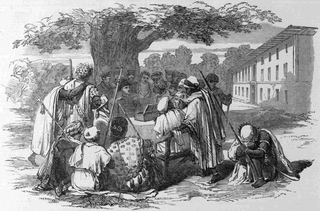 W
WThe Soninke-Marabout War of 1850 to 1856 was a civil war between factions of the Kingdom of Kombo in the Gambia. The war resulted from a dispute between the Soninke people – pagans who were the ruling class in Kombo – and the Marabouts – a radical Muslim group with no representation in the governance of Kombo, partially inspired by Jihad. The British Empire, to whom parts of Kombo had been ceded by the Soninke since 1816, was initially reluctant to intervene. However, during the course of the war, the British intervened on two occasions. British forces stormed the Marabout town of Sabbajee twice, in 1853, and again in 1855, raising the town following the second intervention.
 W
WThe Sosso Empire was a twelfth-century Kaniaga kingdom of West Africa.
 W
WEl-Hadji Malick Sy was a Senegalese religious leader and teacher in the Tijaniyya Sufi Malikite and Ash'arite brotherhood.
 W
WTakrur, Tekrur or Tekrour was an ancient state of West Africa, which flourished roughly parallel to the Ghana Empire.
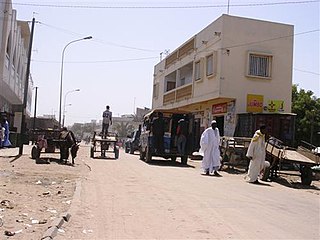 W
WThiaroye is the name of a historic town in Sénégal, situated in the suburbs of Dakar, on the southeast coast of the Cap-Vert peninsula, between Pikine and Rufisque.
 W
WThe Toucouleur Empire (1861–1890) was founded in the mid-nineteenth century by Omar Saidou Tall of the Toucouleur people, in part of present-day Mali.
 W
WThe Emirate of Trarza was a precolonial state in what is today southwest Mauritania. It has survived as a traditional confederation of semi-nomadic peoples to the present day. Its name is shared with the modern Region of Trarza. The population, a mixture of Berber tribes, had been there for a long time before being conquered in the 11th century by Hassaniya Arabic speakers from the north. Europeans later called these people Moors/Maures, and thus have titled this group "the Trarza Moors".
 W
WUpper Senegal and Niger was a colony in French West Africa, created on 21 October 1904 from colonial Senegambia and Niger by the decree "For the Reorganisation of the general government of French West Africa".
 W
WWalo was a kingdom on the lower Senegal River in West Africa, in what are now Senegal and Mauritania. It included parts of the valley proper and areas north and south, extending to the Atlantic Ocean. To the north were Moorish emirates; to the south was the kingdom of Cayor; to the east was Jolof.
 W
WIn World War II, French West Africa was not a major scene of major fighting. Only one large-scale action took place there: the Battle of Dakar. The region remained under the control of Vichy France after the fall of France and until the Allied invasion of North Africa. French Gabon, the only colony of French Equatorial Africa not to join Free France after the armistice, fell to invading Free French Forces from the neighbouring colonies after the Battle of Gabon, further isolating West Africa.